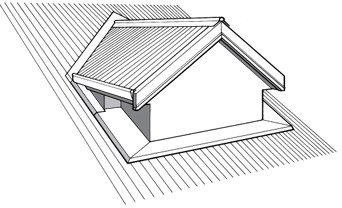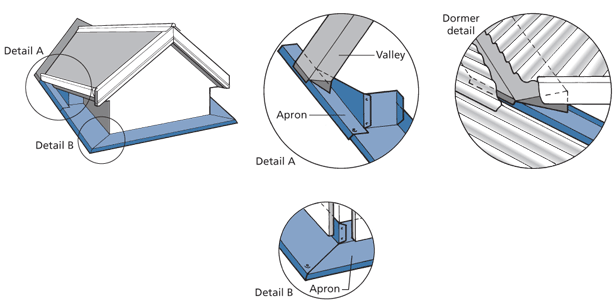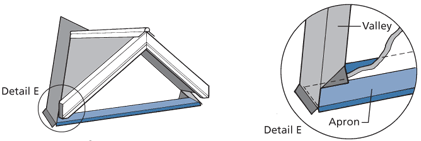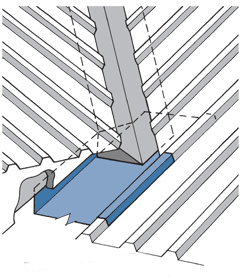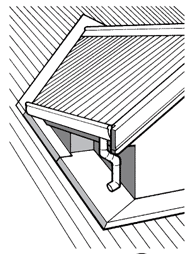Dormer Junctions
The valley is the back-curb of a wide cricket penetration and the designer should consider the catchment area restrictions on discharging into one pan. Large volumes of water can result in overflowing the profile with low trapezoidal or corrugate profiles.
Designers should ascertain that the capacity of the chosen profile is adequate for the catchment area, and for the 50-year return period of rainfall in the building location. See Obstruction.
Dormer windows can be broadly classified into three types:
All of these can be situated either in the body of the roof structure or at the gutter line.
SPOUTING AND BARGE BOARD OF THE DORMER OMITTED FROM THE DRAWINGS FOR CLARITY
When fibre-cement or weatherboard cladding is used, the sequencing of the dormer flashings is critical for weathertightness. Apron flashings are custom made and require a profile set out if the roof cladding is not in position, or if the flashings are to be installed prior to the wall cladding.
An alternative apron design is to make a two-piece apron with an overflow flashing installed first. It is difficult to install apron flashings after the cladding, unless the contractor leaves the cladding unfixed, or alternatively screwed, to allow retrofitting. See Apron Flashings.
The roof cladding profile will determine the details required to provide a weathertight solution. Although the traditional solution for corrugated profile is to distort the the profile by the rib height, it is not acceptable for ribbed or trapezoidal profiles.
The rainwater exit should be planned to produce a weathertight and aesthetically acceptable detail that does not rely on sealant alone. When water should drain from the 'under' to the 'over', a transition is required which can be similar to the tapered detail shown in Type C Tapered and the design should be known and approved by all concerned before the roof cladding is laid.
In some cases the roof framing may have to be altered to enable positive draining, but roof fixers should not change structural members without approval.
The detail in Dog Kennel Without Overhang is shown without any dormer overhang, and the detail is similar to one with an overhang, except that a transition flashing is required to raise the discharge level from under to over.
- The apron flashing is formed at the pan level with an overlap carried up beyond the valley exit.
- The apron upstand is cut to the horizontal line of the barge and is covered by the fascia board.
- The valley is carried past to overlap the apron and is folded down to weather and birdproof the transition, making the apron an extension of the valley.
- Where the dormer finishes at the wall line the apron can drain directly into the gutter.
- Log in to post comments

